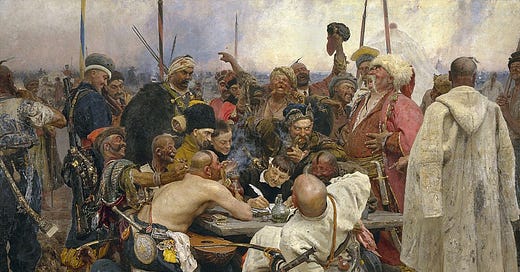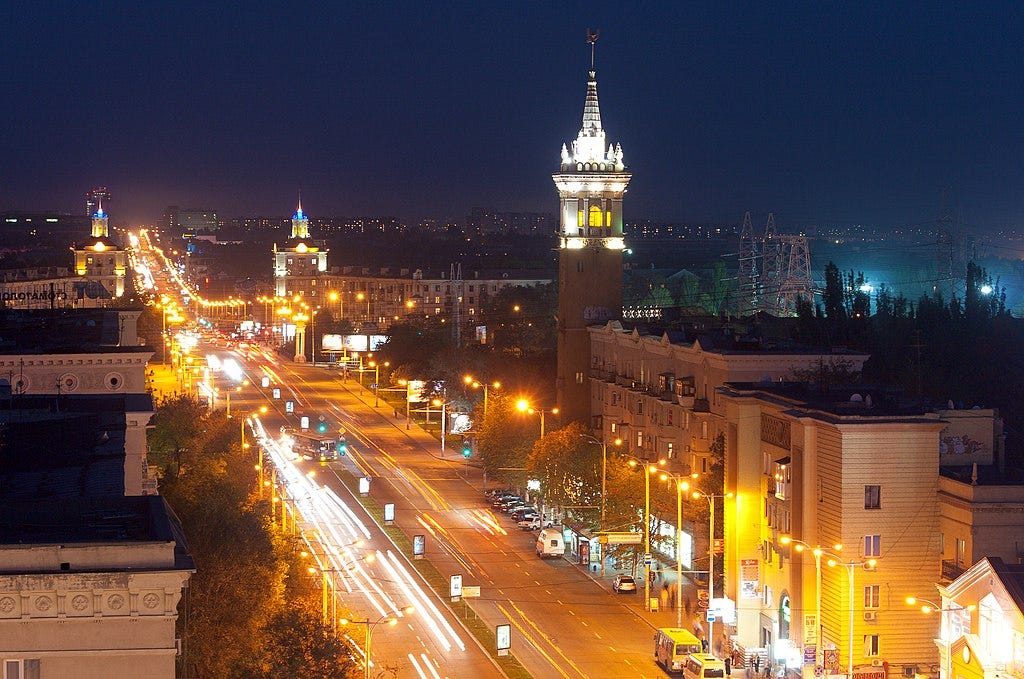The History Between Ukraine and Russia - Part 1
Origins of Ukrainians and How Russia and Europe Got Involved
This was originally going to be a script for a video, but as I’ve noted before on Substack, videos are notoriously time consuming compared to the medium of text, so I’ve decided to write about this on Substack instead.
Preface
If you’re baffled about the whole situation with Ukraine and Russia, you’re not alone. With media outlets spinning propaganda for either side of the war, a distorted picture has been spun with very little digging into the history between the two.
Even those that have done digging, have often done some cursory digging, often to just 2014 and have not gone back to cover the overall history between Ukraine and Russia, who owns what, why and where.
So, allow me to cover the subject and hopefully answer the many questions you have on both the cultures and the war in a multi-part series covering the history between Ukraine and Russia in-depth.
Before Ukraine, There Were Zaporozhian Cossacks
Like how Anglo-Saxons were the predecessors to Britons, before Ukraine, there were the Zaporozhian Cossacks.
These were a semi-nomadic people who originated from the Pontic–Caspian steppe, an area that overlaps parts of both modern-day Russia and Ukraine, and touches other nations including Moldova, Romania and Kazakhstan.
A nomad is someone who roams from one place to another and have no permanent residence. Cossacks slowly settled in areas, grew agriculture and worked military jobs.
Cossack is an Old East Slavic word which means "free man" in the sense of an "adventurer". Russians even have a saying that roughly translates into "free as a Cossack".
Region of Zaporizhzhia
Zaporizhzhia would be in the central east of modern-day Ukraine, below the Dnieper River rapids. The name Zaporizhzhia roughly translates as “(territory) beyond the rapids”, and was the name of the territory of the Cossack state, the Zaporozhian Host, whose fortified capital was the Zaporizhian Sich.
The word ‘Sich’ (translating roughly as ‘to chop’) is a sort of military fort. The Zaporozhian Host (or Zaporizhian Sich) is a term for a military force inhabiting and originating from Zaporizhzhia, from the 16th to the 18th centuries (1501-1701).
If Zaporozhia sounds vaguely familiar, it is a city within modern-day Ukraine.
Big Beef With The Polish-Lithuanian Commonwealth
If you’re wondering why Poland is eager about Ukraine, it is because it paradoxically shares an antagonistic history with Zaporozhian Cossacks, and thus indirectly, Ukraine.
Zaporozhia used to be under the control of the Polish-Lithuthian Commonwealth, until eventually, the Zaporozhian Cossacks were unhappy with being oppressed by the Polish-Lithuthian Commonwealth, the Roman Catholic Church and Jewish elements (bear this last part in mind for later), and in 1648 started the Khmelnytsky Uprising.
Cossacks were effectively treated as though second-class citizens in their own region, more akin to a vassal state with no rights than a fully fledged country. Although the Cossacks would go on to score a number of victories against the Polish-Lithuthian Commonwealth, even getting the Cossacks’ major enemies, the Tatars (early Turks, part of the Ottoman Empire) to join them, they would eventually start to lose battles, and were being forced to sign treaties.
Cossacks Lose the War
The Cossacks were forced to sign the Treaty of Bila Tserkva in 1651 with the Polish-Lithuanian Commonwealth, which essentially resumed the oppression they had fought against previously.
Sensing they would be even more brutally oppressed than ever before by the Polish-Lithuthian Commonwealth, the Zaporozhian Cossacks decided the best thing to do would be to approach the Russians, who had largely not been aggressive to them, and had a particular axe to grind against the Polish-Lithuthian Commonwealth, and ask them for help.
Enter the Russian Empire
Russia warmly and openly embraced them, seeing the Cossacks - who originated from land that also spanned Russia - as native Russian brothers and sisters. It is why Russia to this day still see Russian speaking Ukrainians as under their protection.
However, Russia, being an empire, was still pragmatic. It would not be fair for them to lose Russian men fighting the Polish-Lithuthian Commonwealth unless the Cossacks also did their part, and also made concessions to Russia.
The Cossacks sent diplomats in 1653 to the Russian Tsar Aleksey Mikhaylovich, starting the process for the Pereiaslav Agreement, also known as the March Articles, where the Cossacks would accept concessions and join the Russians in exchange for military protection from the Polish-Lithuanian Commonwealth.
Russia declared war on the Polish-Lithuanian Commonwealth in November 1653 barely months later, triggering the Russo-Polish War, also known as the 13 Years war.
Historical Kharkov
In response to the war, the Russians built a military fort in 1654 in the region they called Kharkov. If that sounds familar, it's because Kharkov is now a major city of modern-day Ukraine like Zaporozhia. It is also why Russia see Kharkov as a city to liberate, as from their point of view the historic fort was designed to protect the Cossacks.
Whilst the war was being waged, the Cossacks also signed the Treaty of Hadiach, 1658 and the Pereiaslav Articles, 1659, with the Russian empire, formally cementing their relations between the two.
The Zaporizhian Host was effectively a Cossack Hetmanate; Hetmanate derived from the word ‘Hetman’, in this case meaning the highest ranking Cossack Military General.
A Split By The River
However, it wasn’t all smooth sailing. The war between Russia and the Polish-Lithuanian Commonwealth was not going as well as the Russians had hoped, and thus they were forced to an agree a treaty - the Treaty of Andrusovo.
The 1667 Treaty of Andrusovo – conducted without any representation from the Cossack Hetmanate – established borders between the Polish and Russian states, dividing the Hetmanate in half along the Dnieper and putting the Zaporizhian Sich under a formal joint Russian-Polish administration.
This essentially divided the rough area of the Zaporizhian region in two, the split had historic reverberations on the demographic of future Ukraine. It is why the western side of Ukraine largely speaks Ukrainian, and the eastern side largely speaks Russian.
The Unhappy Cossacks Try to Leave
Naturally, being split in two doesn’t sit well with the Cossacks, who feel let down by Russia. Ivan Mazepa in 1708 tries a failed attempt to break the union with Russia, at which point the whole area was included into the Government of Kiev.
This is historically also why Kiev was the centre Capital of Ukraine, given Russia concentrated all of the decision making governance there. Technically speaking the Cossacks have some autonomy, but even that is to disappear.
Russia Gets Into A War With The Ottoman Empire (Modern-day Turkey)
The Russo-Turkish War of 1735–1739 sees Russia invade the Crimean Khanate (a khan was a type of leader), in response to all the slavery and raiding parties they had been conducting against Russia.
If ‘Crimean Khanate’ sounds familiar, it is because they controlled a good portion of modern-day Crimea. Russia managed to successfully invade, effectively burning the Crimean Khanate to the ground and crippling them. Russia was aided by Austria during this war.
Another war broke out between Russia and Turkey, the Russo-Turkish War of 1768–1774, ending with the Treaty of Küçük Kaynarca. For modern day reference, Turkey is south of Ukraine, and the Tatars (historic Turks) used to fight with the Cossacks.
In the Treaty of Küçük Kaynarca, Russia gained control of the ports of Azov, Kherson, Kerch, and Enikale (Yeni-Kale), the last two of which are part of Crimea. Russia gained full access to the sea of Azov and effectively gained access to the Black sea.
Crimea still remained largely Muslim, still being a part of the Crimean Khanate, however the Crimean Khanate effectively gained independence from the Turkish empire under the Treaty of Küçük Kaynarca. This also explains why Russia considers Crimea to be a part of Russia.
Russia Consolidates Cossack Administration During The War
1764 through to 1781, with the Turkish war in 1768, the Cossack Hetmanate was incorporated as the Little Russia Governorate headed by Pyotr Rumyantsev, with the last remnants of the Hetmanate's administrative system abolished in 1781, effectively signalling the end of the Cossack Hetmanate.
In 1783, Russia would establish the port of Sevastopol as a major base for their Black sea fleet following this victory against the Ottoman empire and gaining access to the Black sea, and is primarily why Russia considers the city of Sevastopol to be a part of Russia, even as the west insists it is a part of Ukraine.
By 1802, the ‘Little Russia Governorate’ proved to be too big to manage, and in February 1802 the Governorate was split into the Chernigov Governorate and Poltava Governorate. This is where the modern day cities of Chernigov (‘Chernihiv’) and Poltava in Ukraine come from.
Russian Empire Weakens
Cossacks effectively became part of Russia’s fighting force as they integrated with Russia, and helped Russia during the Crimean wars of 1853-1856.
…Right through the line they broke;
Cossack and Russian
Reeled from the sabre stroke…
Lines from the Poem: The Charge of the Light Brigade, by Alfred Tennyson
The Crimean war would lead to a defeat weakening the Russian empire, exposing serious flaws in the military strategy of the Russians and provoking military reforms. Russian Tsar Nicholas would die of illness during the war, experiencing stress from the failures.
In Russia itself, the Crimean defeat discredited the armed services and highlighted the need to modernize the country's defences, not just in the strictly military sense, but also through the building of railways, industrialization, sound finances and so on…
Professor of History, Orlando Figes
It’d also prompt Russia to sell Alaska to the US, fearing how easily captured it would be by American forces if they went to war. It would prompt later reforms in how the Russian military conducted itself.
Part 2 of The History Between Ukraine and Russia covers from the Communist Revolution onwards.
If you like my work, be sure to support it by sharing the article link with other people, subscribing or even becoming a supporter. Thank you!










It’d also prompt Russia to sell Alaska to the US, fearing how easily captured it would be by American forces if they went to war. It would prompt later reforms in how the Russian military conducted itself.
Actually, Russia was afraid after Crimean war (in which Britain was the enemy), that British (from Canada) would easily overrun Alaska, so selling it seemed like a good choice. During American civil war, Russia was very much aligned with the North and that support discouraged British and French to intervene on the side of the South, which sealed their fate.